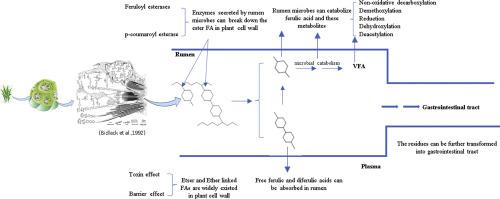Animal Nutrition ( IF 6.3 ) Pub Date : 2022-03-24 , DOI: 10.1016/j.aninu.2022.02.003 Yan-Lu Wang 1 , Wei-Kang Wang 1 , Qi-Chao Wu 1 , Hong-Jian Yang 1

|
Ferulic acid (FA) is one of the most abundant hydroxycinnamic acids in the plant world, especially in the cell wall of grain bran, in comparison with forage and crop residues. Previous studies noted that FA was mainly linked with arabinoxylans and lignin in plant cell walls in ester and ether covalent forms. After forages were ingested by ruminant animals or encountered rumen microbial fermentation in vitro, these cross-linkages form physical and chemical barriers to protect cell-wall carbohydrates from microbial attack and enzymatic hydrolysis. Additionally, increasing studies noted that FA presented some toxic effect on microbial growth in the rumen. In recent decades, many studies have addressed the relationships of ester and/or ether-linked FA with rumen nutrient digestibility, and there is still some controversy whether these linkages could be used as a predicator of forage digestibility in ruminants. The authors in this review summarized the possible relationships between ester and/or ether-linked FA and fiber digestion in ruminants. Rumen microbes, especially bacteria and fungi, were found capable of breaking down the ester linkages within plant cell walls by secreting feruloyl and p-coumaroyl esterase, resulting in the release of free FA and improvement of cell wall digestibility. The increasing evidence noted that these esterases secreted by rumen microbes presented synergistic effects with xylanase and cellulase to effectively hydrolyze forage cell walls. Some released FA were absorbed through the rumen wall directly and entered into blood circulation and presented antioxidant effects on host animals. The others were partially catabolized into volatile fatty acids by rumen microbes, and the possible catabolic pathways discussed. To better understand plant cell wall degradation in the rumen, the metabolic fate of FA along with lignin decomposition mechanisms are needed to be explored via future microbial isolation and incubation studies with aims to maximize dietary fiber intake and enhance fiber digestion in ruminant animals.
中文翻译:

瘤胃微生物对植物细胞壁阿魏酸的释放与分解代谢:综述
与草料和作物残茬相比,阿魏酸 (FA) 是植物界中含量最丰富的羟基肉桂酸之一,尤其是在谷糠的细胞壁中。先前的研究指出,FA 主要以酯和醚共价形式与植物细胞壁中的阿拉伯木聚糖和木质素相关联。在反刍动物摄入草料或在体外遇到瘤胃微生物发酵后,这些交联形成物理和化学屏障,以保护细胞壁碳水化合物免受微生物攻击和酶水解。此外,越来越多的研究指出,FA 对瘤胃中的微生物生长具有一定的毒性作用。近几十年来,许多研究已经解决了酯和/或醚连接的 FA 与瘤胃养分消化率的关系,这些联系是否可以用作反刍动物饲料消化率的预测指标,仍然存在一些争议。本综述的作者总结了反刍动物中酯和/或醚连接的 FA 与纤维消化之间可能存在的关系。瘤胃微生物,尤其是细菌和真菌,被发现能够通过分泌阿魏酰和p-香豆酸酯酶,导致游离FA的释放和细胞壁消化率的提高。越来越多的证据表明,这些由瘤胃微生物分泌的酯酶与木聚糖酶和纤维素酶具有协同作用,可有效水解牧草细胞壁。部分释放的FA通过瘤胃壁直接吸收进入血液循环,对宿主动物表现出抗氧化作用。其他部分被瘤胃微生物分解代谢成挥发性脂肪酸,并讨论了可能的分解代谢途径。为了更好地了解瘤胃中植物细胞壁的降解,



























 京公网安备 11010802027423号
京公网安备 11010802027423号